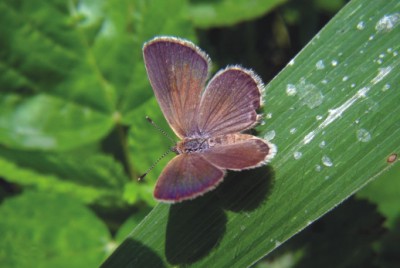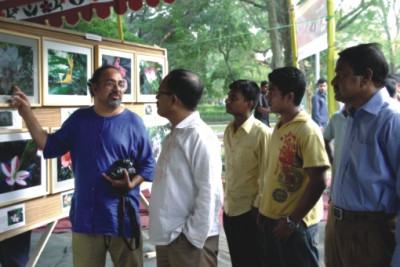Endeavour
Pulse of the Park
Jessica Mudditt
The doctor told him that his heart could not withstand deep-sea diving. Nor would it cope with

Grass Blue Butterfly. |
paragliding, so the trip to India was cancelled. Even carrying his camera equipment could cause a fatal strain. The doctor told Raguib Uddin Ahmed that he must only do small things from now on.
And yet, three years later, Raguib's exhibition in Ramna Park proved to be anything but small. So many people turned up for a glimpse of his latest photography collection last Saturday that he had to call the police for crowd control.
“It was like a cyclone,” he said, smiling.
This thoughtful man who stood before me while an enraptured crowd hung on his every word has a medical history that many of us daren't dream of. In 2006 Raguib had a heart attack and consequently underwent a heart bypass. He suffered a second heart attack the following year and surgeons kept his heart beating by inserting wire rings. A few months later, he endured the agony of an infection, and he underwent the most painful operation of all.
So Raguib was in a very weak state when he first started visiting Ramna Park. Like thousands of others, Raguib came to one of Dhaka's biggest green spaces to ease his ailments with a daily dose of fresh air. The 56 acre park provides respite for many cardiac patients and diabetics, as well as those seeking to postpone the pains of old age.
Raguib told me that he overheard many conversations while he quietly sat in the park on his own. He summarised the contents of the conversations between those convalescing in a single sentence: "Life is hell and I would like to go to my grave as soon as possible."
But Raguib felt just the opposite. By fashioning a new lens onto his lightweight compact camera, he began taking macroscopic photographs of the beautiful and rare plants and insects that inhabit Ramna Park. His collection of photographs would later turn into a highly successful exhibition, aptly named “Pulse of the Park.”
Raguib, who has a degree in zoology from Dhaka University, had quickly discovered that the park is teeming with rare species of flora and fauna. The Devil's Cotton, the Indian Cupid, the Watermelon Worm Moth, the Lynx Spider, the Cotton Stained Bug and the Lipstick Tree are just a tiny selection of the 118 species Raguib presented to the public between 11-14 November.
 |
| Yellow Man Face Bug |
Superb Lily or Ulat Chandal |
Raguib also invested a lot of his time in developing techniques to get closer and closer to the camera shy creatures.
He described how he photographed Bangladesh's tiniest butterfly from a distance of just one centimetre: "When I was six or seven feet away, I spat on the leaf. I did this so that the butterfly could smell me, get used to me. After a few minutes it flew away, but it returned to the same place. I waited five minutes and then I came another foot closer. I kept doing this until I was just one centimetre away."
Raguib uses a variety of techniques to ingratiate himself amongst the insects, but the one thing he always tries to do, he said, is establish a friendship.
Of the Brown Stink Bug, he said: “If you ask anyone in the park, they'll tell you they won't get close to this insect because it gives off a pheromone. But you can see in the photograph that it is sitting on my finger. It did not release the smell, and after taking 10 pictures, I released it.”

Raguib Uddin Ahmed with guests at his exhibition |
Raguib is also quick to point out that nature reveals a lot about what makes Ramna Park special. One of his photographs contains a stunning close-up of the Kachpoka, a creature that faintly resembles a millipede, yet has more in common with a shrimp than any insect. Its ancestors are three million years old. The fact that it has been discovered here in the park, he said, indicates that the land has been forested for at least a million years.
The park as it exists today is 400 years old and a tenth of its original size. The deep forest was cleared by the Mughal ruler Islam Khan, who turned it into a park for the benefit of his people. At the time, Farsi was spoken amongst the ruling elite: "Ramna" translates to “green grassy surface.” Subsequent powers have tried to change the park's name, but each attempt has been rejected by the people.
Raguib's exhibition also seeks to highlight the fragility of the park's ecosystem. He has photographed several plants that scientists estimate will become extinct within the next decade.
Raguib said, “I hope this exhibition makes people more environmentally aware. I want others to realise that there is much biodiversity in this park, and that we must be careful to preserve it.
“I am asking people to do something for nature. Don't say only words - do things. If you see someone damaging the flowers, stop them.”
He added, “If there is biodiversity such as this in Ramna Park, then imagine the biodiversity of the whole Bangladesh.”
To view Raguib's photography collection, including his new project involving a series of Dhaka's oldest buildings, visit http://www.flickr.com/photos/raguib
Email Raguib at raguib.ahmed@yahoo.com
Copyright
(R) thedailystar.net 2009 |
